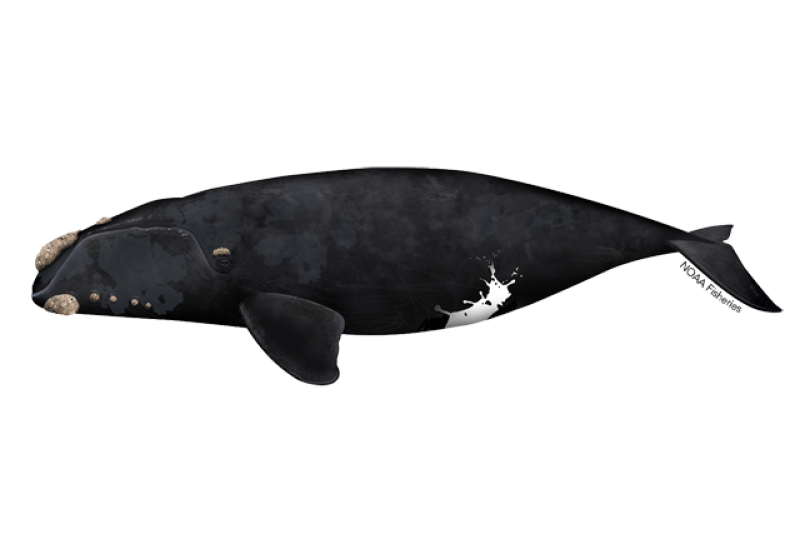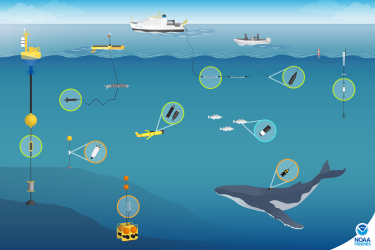Sei Whale
Balaenoptera borealis

Protected Status
Quick Facts
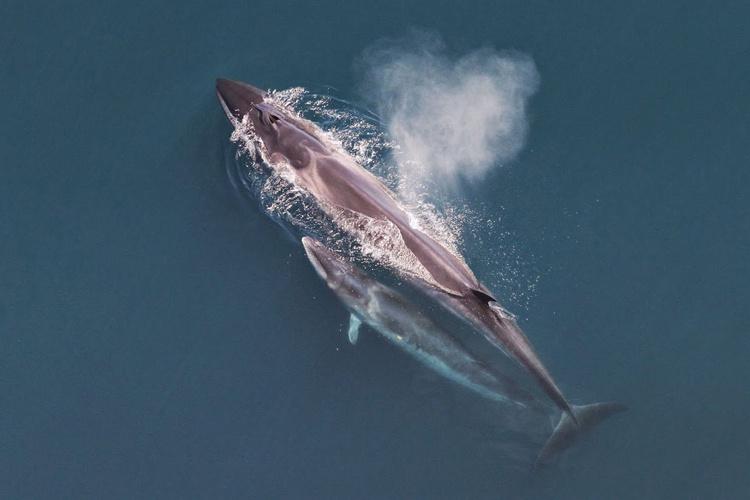 Sei whale mother and calf. Credit: NOAA Fisheries
Sei whale mother and calf. Credit: NOAA Fisheries
Sei whale mother and calf. Credit: NOAA Fisheries
About the Species
 Sei whale mother and calf. Credit: NOAA Fisheries
Sei whale mother and calf. Credit: NOAA Fisheries
Sei whale mother and calf. Credit: NOAA Fisheries
Sei whales occur in subtropical, temperate, and subpolar waters around the world. Often found with pollock in Norway, the name "sei" comes from the Norwegian word for pollock, "seje."
The global sei whale population was greatly decreased by historical commercial whaling during the 19th and 20th centuries. An estimated 300,000 sei whales were killed for their meat and oil.
Member countries of the International Whaling Commission (IWC) agreed to cease sei whale catches in the North Pacific in 1975 and in the Antarctic in 1979. In 1982, the IWC decided to cease commercial whaling on all whale species and populations from the 1985/1986 season onward. Although whaling is no longer a major threat, some whaling of this species continues today in Japan. Vessel strikes and entanglement pose the biggest threat to sei whales today. The sei whale is listed as endangered under the Endangered Species Act and depleted under the Marine Mammal Protection Act.
NOAA Fisheries and our partners are dedicated to conserving and rebuilding the sei whale population. We use a variety of innovative techniques to study, protect, and rescue these endangered whales. We engage our partners as we develop regulations and management plans that foster healthy fisheries and reduce the risk of entanglements, create whale-safe shipping practices, and reduce ocean noise.
Population Status
The sei whale is listed as endangered under the Endangered Species Act. The species is also designated as depleted under the Marine Mammal Protection Act. The total population of sei whales in all U.S. waters is unknown.
The most recent population assessments can be found on the sei whale stock assessment reports.
Appearance
Sei whales have a long, sleek body that is dark bluish-gray to black in color and white or cream-colored on the underside. The body is often covered in oval-shaped scars (probably caused from cookie-cutter shark and lamprey bites) and sometimes has subtle "mottling," or discolored spots or blotches.
Sei whales have a tall, hooked dorsal fin located about two-thirds down their back. Sei whales have 219 to 410 baleen plates (long plates made out of keratin, the same material as our fingernails, instead of teeth) that are dark in color with gray/white fine inner fringes in their enormous mouths. They also have 30 to 65 relatively short accordion-like creases, or throat grooves, that extend from below the mouth to the naval area. The number of throat grooves and baleen plates may differ depending on geographic population.
At the water's surface, sei whales can be recognized by a columnar or bushy blow that is about 10 to 13 feet high. The dorsal fin usually appears at the same time as the blowhole when the animal surfaces to breathe.
Behavior and Diet
Sei whales are usually observed alone or in small groups of two to five animals. They are fast swimmers that can reach speeds of over 34 miles per hour.
Sei whales dive differently than most whales. They do not arch their backs or show their flukes before diving; they simply sink below the surface. They often leave “fluke prints”—smooth circles on the surface created by the movement of the fluke underwater.
An average sei whale eats about 2,000 pounds of food per day. They can dive 5 to 20 minutes to feed on plankton (including copepods and krill), small schooling fish, and cephalopods (including squid) by both gulping and skimming. They prefer to feed at dawn and may exhibit unpredictable behavior while foraging and feeding on prey.
Where They Live
Sei whales have a wide distribution and live in subtropical, temperate, and subpolar waters around the world. They prefer temperate waters in the mid-latitudes, and can be found in the Atlantic, Indian, and Pacific Oceans. During the summer, they are commonly found in the Gulf of Maine, and on Georges Bank and Stellwagen Bank off the U.S. coast in the western North Atlantic. The movement patterns of sei whales are not well known, but they are typically observed in deeper waters far from the coastline. Sei whales have an unpredictable distribution. Many whales may be found in one area for a period and then not return for years or decades. This behavior is unusual for large whales, who generally have a predictable distribution. It is currently unknown where sei whales breed.
 World map providing approximate representation of the sei whale's range.
World map providing approximate representation of the sei whale's range.
Lifespan & Reproduction
Sei whales become sexually mature at 6 to 12 years of age when they reach about 45 feet in length. They generally mate and give birth during the winter in lower latitudes.
Females breed every 2 to 3 years, with a gestation period of 11 to 13 months. Calves are about 15 feet long and weigh about 1,500 pounds at birth. Mothers nurse their calves for 6 to 9 months before weaning them at their preferred feeding grounds.
Threats
Vessel Strikes
Inadvertent vessel strikes can injure or kill sei whales. The projected increase in ship traffic arising from the opening of trans-polar shipping routes (as arctic sea ice melts) will likely increase the risk of vessel strikes as well as ambient noise and pollution.
Entanglement
One of the main threats to sei whales is getting caught in fishing gear. They can become entangled in gear such as traps, pots, and gillnets. Once entangled, whales may swim for long distances with gear attached, resulting in fatigue, compromised feeding ability, or severe injury. These conditions can lead to reduced reproductive success and death.
Ocean Noise
Underwater noise threatens whale populations, interrupting their normal behavior and driving them away from areas important to their survival. Increasing evidence suggests that exposure to intense underwater sound in some settings may cause some whales to strand and ultimately die.
Climate Change
The impacts of climate change on baleen whales may result from altered oceanographic conditions, as well as the timing and distribution of sea ice coverage. Changes in prey distribution could lead to changes in foraging behavior, nutritional stress, and diminished reproduction for sei whales. Additionally, changing water temperature and currents could impact the timing of environmental cues important for navigation and foraging.
Scientific Classification
| Kingdom | Animalia | Phylum | Chordata | Class | Mammalia | Order | Cetacea | Family | Balaenopteridae | Genus | Balaenoptera | Species | borealis |
|---|
Last updated by NOAA Fisheries on 11/26/2024
What We Do
Conservation & Management
NOAA Fisheries is committed to the protection and recovery of sei whales, and takes targeted management actions to protect these whales:
- Minimizing the effects of noise disturbance
- Responding to stranded sei whales
- Developing oil spill response plans
- Reviewing projects that could harm sei whales
- Educating the public about sei whales and the threats they face
- Monitoring population abundance and distribution
Science
Our research projects have discovered new aspects of sei whale biology, behavior, and ecology, and helped us better understand the challenges that all sei whales face. This research is especially important in rebuilding endangered populations. Our work includes the following:
- Stock assessments
- Measuring sei whales response to sound
How You Can Help
Keep Your Distance
Be responsible when viewing marine life in the wild. Observe all large whales from a safe distance of at least 100 yards and limit your time spent observing to 30 minutes or less.
Report Marine Life in Distress
Report a sick, injured, entangled, stranded, or dead animal to make sure professional responders and scientists know about it and can take appropriate action. Numerous organizations around the country are trained and ready to respond. Never approach or try to save an injured or entangled animal yourself—it can be dangerous to both the animal and you.
Learn who you should contact when you encounter a stranded or injured marine animal
Report a Violation
Call the NOAA Fisheries Enforcement Hotline at (800) 853-1964 to report a federal marine resource violation. This hotline is available 24 hours a day, 7 days a week for anyone in the United States.
You may also contact your closest NOAA Office of Law Enforcement field office during regular business hours.
Featured News
 A school of northern right whale dolphins observed off Oregon on the recent Southwest Fisheries Science Center marine mammal survey. Image collected under NOAA Fisheries research permit #22306. Credit: NOAA Fisheries/Cory Hom-Weaver.
A school of northern right whale dolphins observed off Oregon on the recent Southwest Fisheries Science Center marine mammal survey. Image collected under NOAA Fisheries research permit #22306. Credit: NOAA Fisheries/Cory Hom-Weaver.
Four-Month Survey Tracking West Coast Marine Mammals Finds Some Shifting North
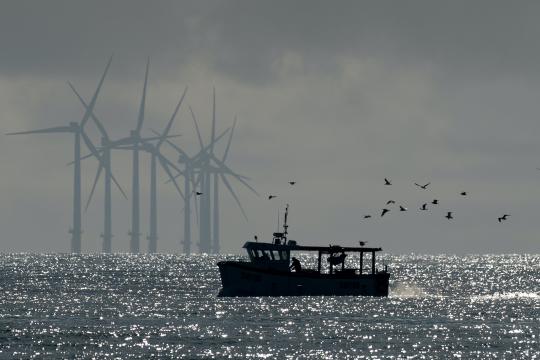 A small fishing vessel near wind turbines. Credit: Bob Brewer on Unsplash
A small fishing vessel near wind turbines. Credit: Bob Brewer on Unsplash
Studying Sound in the Ocean to Prepare for Offshore Wind Development

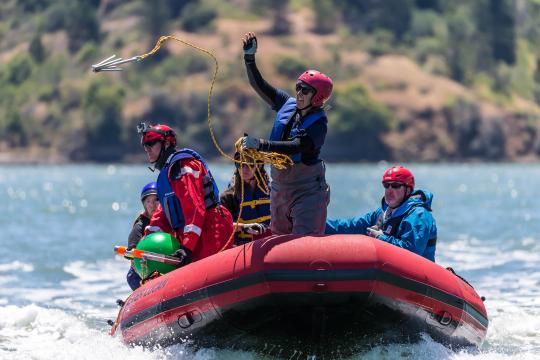 Kathi George participating in whale disentanglement training. Credit: Bill Hunnewell/The Marine Mammal Center
Kathi George participating in whale disentanglement training. Credit: Bill Hunnewell/The Marine Mammal Center
Management Overview
The sei whales is listed as endangered under the Endangered Species Act.
The sei whale is protected throughout its range under the Marine Mammal Protection Act.
The sei whale is depleted under the Marine Mammal Protection Act.
Additionally, the sei whale is listed under:
- Appendix I of the Convention on International Trade in Endangered Species of Wild Fauna and Flora (CITES)
- Annex II of the Protocol for Specially Protected Areas and Wildlife (SPAW)
Recovery Planning and Implementation
Recovery Action
Under the ESA, NOAA Fisheries develops and implements recovery plans for the conservation and survival of listed species. The Recovery Plan for the Sei Whale was published in December 2011. The plan aims to recover the species, with an interim goal of down-listing the sei whale status from "endangered" to "threatened."
The major actions recommended in the plan are:
- Reduce or eliminate injury or mortality caused by ship collision
- Reduce or eliminate injury and mortality caused by fisheries and fishing gear
- Protect habitats essential to the survival and recovery of sei whales
- Minimize effects of vessel disturbance
- Continue international ban on hunting and other directed take
- Monitor the population size and trends in abundance
- Maximize efforts to free entangled or stranded sei whales
- Acquire scientific information from dead specimens
Learn more about the recovery plan for sei whales

Implementation
NOAA Fisheries is working to minimize effects from human activities that are detrimental to the recovery of sei whale populations in the United States and internationally. Together with our partners, we support the goals of the sei whale recovery plan, with the ultimate goal of delisting the species.
Conservation Efforts
Reducing Vessel Strikes
Collisions between whales and large vessels can injure or kill the whales and damage the vessels, but strikes often go unnoticed and unreported. The most effective way to reduce collision risk is to keep whales and vessels away from one another. If this is not possible, the second best way is for vessels to slow down and keep a lookout.
Learn more about reducing vessel strikes
Addressing Ocean Noise
Underwater noise may threaten sei whales by interrupting their normal behavior and driving them away from areas important to their survival. Mounting evidence suggests that exposure to intense underwater sound may cause some marine mammals to strand and ultimately die. NOAA Fisheries is investigating acoustic communication and hearing in marine animals, as well as the effects of sound on whale behavior and hearing. In 2018, we revised technical guidance for assessing the effects of anthropogenic sound on marine mammals’ hearing.
Overseeing Marine Mammal Health and Stranding Response
We work with volunteer networks in all coastal states to respond to marine mammal strandings including all whales. When stranded animals are found alive, NOAA Fisheries and our partners assess the animal’s health and determine the best course of action. When stranded animals are found dead, our scientists work to understand and investigate the cause of death. Although the cause often remains unknown, scientists can sometimes attribute strandings to disease, harmful algal blooms, vessel strikes, fishing gear entanglements, pollution exposure, and underwater noise. Some strandings can serve as indicators of ocean health, giving insight into larger environmental issues that may also have implications for human health and welfare.
Learn more about the Marine Mammal Health and Stranding Response Program
Marine Mammal Unusual Mortality Events
Sei whales have never been part of a declared unusual mortality event. Under the Marine Mammal Protection Act, an unusual mortality event is defined as "a stranding that is unexpected; involves a significant die-off of any marine mammal population; and demands immediate response." To understand the health of marine mammal populations, scientists study unusual mortality events.
Regulatory History
The sei whale has been listed as endangered since 1970. It was originally listed as endangered under the Endangered Species Conservation Act, the precursor to the ESA, in June 1970. The species is also designated as depleted under the MMPA.
In 1986, the International Whaling Commission, a group composed of countries from all over the world, paused commercial whaling of sei whales for all member nations.
In December 2011, NOAA Fisheries published a final recovery plan for the sei whale.
Key Actions and Documents
Incidental Take Authorization: Scripps Institution of Oceanography's Marine Geophysical Survey in the Nauru Basin of Greater Micronesia in the NW
Incidental Take Authorization: Bay State Wind, LLC Marine Site Characterization Surveys off Rhode Island and Massachusetts
Incidental Take Authorization: Lamont-Doherty Earth Observatory Marine Geophysical Survey of the Chain Transform Fault in the Equatorial Atlantic
Incidental Take Authorization: Orsted Wind Power North America, LLC's Site Characterization Surveys off Delaware
Last updated by NOAA Fisheries on 11/26/2024
Science Overview
NOAA Fisheries conducts research activities on the biology, behavior, and ecology of the sei whale. This research informs management decisions and enhances recovery efforts for this endangered species.

Stock Assessments
Determining the number of sei whales in each population—and whether a stock is increasing or decreasing over time—helps resource managers assess the success of conservation measures. Our scientists collect information and present these data in annual stock assessment reports.
Acoustic Science
NOAA conducts research on the acoustic environment of cetaceans, including sei whales. Acoustics is the science of how sound is transmitted. This research increases our understanding of the basic acoustic behavior of whales, dolphins, and fish; maps the acoustic environment; and develops better methods to locate cetaceans using autonomous gliders and passive acoustic arrays.
Acoustics are used to monitor hearing levels and feeding behavior in sei whales. We also study how underwater noise affects the way sei whales behave, eat, interact with each other, and move within their habitat.
Last updated by NOAA Fisheries on 11/26/2024
Documents
Biological Opinion NOAA Fisheries, Office of Protected Resources, Permits and Conservation Division, Eareckson Air Station Long-term Fuel Pier Repairs, Shemya Island, Alaska
This opinion considers the effects of all in-water activities including vessel transit of materials…
Sei Whale 5-Year Review
This document is the ESA 5-year review of the species based on the best available data.
Biological Opinion on 10 Fishery Management Plans
Biological Opinion on 10 Fishery Management Plans in the Greater Atlantic Region and the New…
Biological Opinion Alaska Liquefied Natural Gas (LNG) Project
Endangered Species Act Section 7(a)(2) Biological Opinion on Alaska Liquefied Natural Gas Project,…
Data & Maps
Passive Acoustic Cetacean Map
This mapping tool shows when and where specific whale, dolphin, and other cetacean species were…
Recovery Action Database
Tracks the implementation of recovery actions from Endangered Species Act (ESA) recovery plans.
Alaska Endangered Species and Critical Habitat Mapper Web Application
Spacial data and maps of critical habitat and Endangered Species Act (ESA) threatened and…
Research
Passive Acoustics Research Group News & Media
Our Passive Acoustics Research Group frequently makes the news. This page links to articles and other media featuring our staff and their research.
Outreach & Education
Acoustic Studies Sound Board Of Marine Mammals In Alaska
This resource features passive acoustic sound clips of many amazing marine mammals that can be…
Last updated by NOAA Fisheries on 11/26/2024


